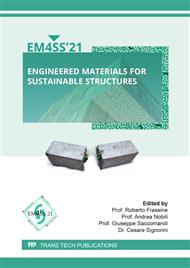[1]
M. Xia, J. Sanjayan, Method of formulating geopolymer for 3D printing for construction applications, Materials & Design. 110 (2016) 382–390.
DOI: 10.1016/j.matdes.2016.07.136
Google Scholar
[2]
M. Xia, B. Nematollahi, J. Sanjayan, Printability, accuracy and strength of geopolymer made using powder-based 3D printing for construction applications, Automation in Construction. 101 (2019) 179–189.
DOI: 10.1016/j.autcon.2019.01.013
Google Scholar
[3]
D. Lowke, D. Talke, I. Dressler, D. Weger, C. Gehlen, C. Ostertag, R. Rael, Particle bed 3D printing by selective cement activation–applications, material and process technology, Cement and Concrete Research. 134 (2020) 106077.
DOI: 10.1016/j.cemconres.2020.106077
Google Scholar
[4]
R. Maskuriy, A. Selamat, K.N. Ali, P. Maresova, O. Krejcar, Industry 4.0 for the construction industry—how ready is the industry?, Applied Sciences. 9 (2019) 2819.
DOI: 10.3390/app9142819
Google Scholar
[5]
R.A. Buswell, W.L. da Silva, F.P. Bos, H. Schipper, D. Lowke, N. Hack, H. Kloft, V. Mechtcherine, T. Wangler, N. Roussel, A process classification framework for defining and describing digital fabrication with concrete, Cement and Concrete Research. 134 (2020) 106068.
DOI: 10.1016/j.cemconres.2020.106068
Google Scholar
[6]
A.U. Rehman, V.M. Sglavo, 3D printing of portland cement-containing bodies, Rapid Prototyping Journal. (2021).
DOI: 10.1108/rpj-08-2020-0195
Google Scholar
[7]
P. Shakor, J. Sanjayan, A. Nazari, S. Nejadi, Modified 3D printed powder to cement-based material and mechanical properties of cement scaffold used in 3D printing, Construction and Building Materials. 138 (2017) 398–409.
DOI: 10.1016/j.conbuildmat.2017.02.037
Google Scholar
[8]
V.M. Sglavo, F. De Genua, A. Conci, R. Ceccato, R. Cavallini, Influence of curing temperature on the evolution of magnesium oxychloride cement, Journal of Materials Science. 46 (2011) 6726–6733.
DOI: 10.1007/s10853-011-5628-z
Google Scholar
[9]
A.U. Rehman, V.M. Sglavo, 3D printing of geopolymer-based concrete for building applications, Rapid Prototyping Journal. (2020).
DOI: 10.1108/rpj-09-2019-0244
Google Scholar
[10]
R. Góchez, J. Wambaugh, B. Rochner, C. Kitchens, Kinetic study of the magnesium oxychloride cement cure reaction., Journal of Materials Science. 52 (2017).
DOI: 10.1007/s10853-017-1013-x
Google Scholar
[11]
I. Astm, ASTM52900-15 standard terminology for additive manufacturing—general principles—terminology, ASTM International, West Conshohocken, PA. 3 (2015) 5.
Google Scholar
[12]
S.-J.J. Lee, Powder layer generation for three dimensional printing, PhD thesis, Massachusetts Institute of Technology, (1992).
Google Scholar
[13]
A. Mostafaei, A.M. Elliott, J.E. Barnes, F. Li, W. Tan, C.L. Cramer, P. Nandwana, M. Chmielus, Binder jet 3D printing—process parameters, materials, properties, modeling, and challenges, Progress in Materials Science. 119 (2021) 100707.
DOI: 10.1016/j.pmatsci.2020.100707
Google Scholar
[14]
X. Lv, F. Ye, L. Cheng, S. Fan, Y. Liu, Binder jetting of ceramics: Powders, binders, printing parameters, equipment, and post-treatment, Ceramics International. 45 (2019) 12609–12624.
DOI: 10.1016/j.ceramint.2019.04.012
Google Scholar
[15]
A.M. Elliott, P. Nandwana, D.H. Siddel, B. Compton, A method for measuring powder bed density in binder jet additive manufacturing process and the powder feedstock characteristics influencing the powder bed density, Oak Ridge National Lab.(ORNL), Oak Ridge, TN (United States). High …, (2016).
DOI: 10.2172/469127
Google Scholar
[16]
G. Jacob, A. Donmez, J. Slotwinski, S. Moylan, Measurement of powder bed density in powder bed fusion additive manufacturing processes, Measurement Science and Technology. 27 (2016) 115601.
DOI: 10.1088/0957-0233/27/11/115601
Google Scholar
[17]
P.K. Tan, Three dimensional printing: Solenoid value-jet for continuous high-speed application, PhD thesis, Massachusetts Institute of Technology, (2000).
Google Scholar
[18]
B. Derby, Inkjet printing of functional and structural materials: Fluid property requirements, feature stability, and resolution, Annual Review of Materials Research. 40 (2010) 395–414.
DOI: 10.1146/annurev-matsci-070909-104502
Google Scholar
[19]
P. Shakor, S. Nejadi, G. Paul, J. Sanjayan, Dimensional accuracy, flowability, wettability, and porosity in inkjet 3DP for gypsum and cement mortar materials, Automation in Construction. 110 (2020) 102964.
DOI: 10.1016/j.autcon.2019.102964
Google Scholar
[20]
J.J. Wagner, H. Shu, R. Kilambi, Experimental investigation of fluid-particle interaction in binder jet 3D printing, (2021).
DOI: 10.20944/preprints202101.0546.v1
Google Scholar
[21]
H.N. Emady, D. Kayrak-Talay, J.D. Litster, Modeling the granule formation mechanism from single drop impact on a powder bed, Journal of Colloid and Interface Science. 393 (2013) 369–376.
DOI: 10.1016/j.jcis.2012.10.038
Google Scholar
[22]
H.N. Emady, D. Kayrak-Talay, J.D. Litster, A regime map for granule formation by drop impact on powder beds, AIChE Journal. 59 (2013) 96–107.
DOI: 10.1002/aic.13952
Google Scholar
[23]
J.F. Bredt, Binder stability and powder/binder interaction in three-dimensional printing., (1997).
Google Scholar
[24]
R. Theagarajan, J. Moses, C. Anandharamakrishnan, 3D extrusion printability of rice starch and optimization of process variables, Food and Bioprocess Technology. 13 (2020) 1048–1062.
DOI: 10.1007/s11947-020-02453-6
Google Scholar
[25]
N.A. Heckert, J.J. Filliben, C.M. Croarkin, B. Hembree, W.F. Guthrie, P. Tobias, J. Prinz, others, Handbook 151: NIST/sematech e-handbook of statistical methods, (2002).
Google Scholar
[26]
H. Miyanaji, Binder jetting additive manufacturing process fundamentals and the resultant influences on part quality., (2018).
DOI: 10.18297/etd/3058
Google Scholar
[27]
R. Ramakrishnan, B. Griebel, W. Volk, D. Günther, J. Günther, 3D printing of inorganic sand moulds for casting applications, in: Advanced Materials Research, Trans Tech Publ, 2014: p.441–449.
DOI: 10.4028/www.scientific.net/amr.1018.441
Google Scholar


